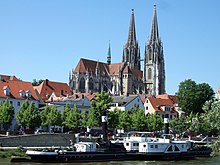 Lionel,
Lionel,Please explain how the theology taught in the SSPX seminaries differs from that which is taught in the manuals that precede the letter from the Holy Office to Archbishop Cushing.
Lionel:
The SSPX is following the same manuals as the pre-Council of Trent times, but they are interpreting hypothetical cases like the baptism of desire and blood and being saved in invincible ignorance as 1) excluding the necessity of th baptism of water in the Catholic Church and 2) as being physically explicit, seen in the flesh cases.This is their irrational premise. Then they conclude that these 'explicit' cases, are practical exceptions to the dogma extra ecclesiam nulla salus(EENS).
The SSPX makes this error when they accept the second part of the Letter of the Holy Office 1949 which assumed that the baptism of desire etc 1) excluded the baptism of water in the Catholic Church and 2) were exceptions to EENS( Feeneyite). If they were exceptions then the inference is that they were known, physically visible , to be exceptions to the traditional interpretation of EENS(Feeneyite).
.jpg)
.jpg)
Then with this new premise (visible cases of the baptism of desire) and conclusion( practical exceptions to traditional EENS) the SSPX interprets Vatican Council II as a break with Tradition and in particular the dogma EENS ( Feeneyite).
This differs with the Council of Trent and pre-Council of Trent times.
In pre-Council of Trent times they had the same manuals but they interpreted the baptism of desire and blood and being saved in invincible ignorance, as referring to hypothetical cases, theoretical cases. This is common sense.
With good will they accepted the possibility of the hypothetical case of a catechumen being saved with the desire for the baptism of water, which he could not receive because of an early death.Hypothetical, that's all.
So for them, over the centuries, in the Catholic church, there were no explicit exceptions to the dogma EENS.
For the SSPX there are explicit exceptions to EENS.The SSPX has an EENS which is Cushingite-, with known exceptions.While the pre-Council of Trent times had an EENS, which was Feeneyite, there being no exceptions.


The SSPX uses the EENS Cushingite reasoning to interpret Vatican Council II as do the bishops and priests in Regensburg and the rest of Germany.
Both the SSPX seminary in Regensburg and the German Catholic (Novus Ordo) seminaries in Germany, accept EENS as Cushingite while the pre-Council of Trent times, affirmed EENS as Feeneyite.St.Thomas Aquinas, St. Augustine, St.Francis of Assisi, St. Robert Bellarmine, St. Francis Xavier, St.Teresa of Avila....were Feeneyite on EENS.




No comments:
Post a Comment